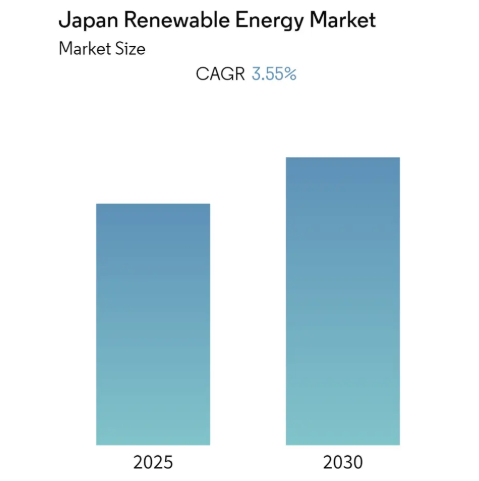
1. Market Overview & Executive Summary
Japan’s renewable energy sector is undergoing significant transformation as the country accelerates its shift toward sustainable energy. The market is expected to grow at a CAGR of 3.55%, with renewable sources projected to make up 36–38% of the energy mix by 2030. Solar energy remains the leading segment, followed by a rapidly growing wind energy sector. Government policy, corporate participation, and technological innovation are key market drivers.
2. Government Strategy and Market Drivers
The government supports renewable energy through various mechanisms such as Feed-in Premium (FiP) and Feed-in Tariff (FiT) systems. Recent regulations mandate solar panel installations on all new homes by 2025. The Ministry of Economy, Trade, and Industry (METI) has conducted successful solar auctions, further driving competitive pricing and project development.
3. Key Market Trends
-
Supportive Government Policies: Ambitious targets for clean energy adoption and regulatory mandates such as solar panel installation requirements on buildings.
-
Corporate Investments and Large-Scale Projects: Notable collaborations such as JERA and West Holdings (1 GW solar projects), and Clean Energy Connect’s 70 MW project for NTT Group.
-
Declining Technology Costs: Advancements in solar photovoltaic (PV) and wind energy technologies have reduced costs and improved efficiency.
-
Technological Innovation: Expansion of high-efficiency solar modules, perovskite solar cells, and offshore wind technologies.
4. Segment Analysis – By Energy Type
-
Solar Energy: Largest contributor with 56% share of installed capacity. Strong policy backing, FiP auctions, and corporate PPAs are driving growth.
-
Wind Energy: Fastest-growing segment due to offshore wind development potential and investor interest.
-
Hydropower and Biomass: Hydropower remains stable; biomass continues to evolve with local waste sources and government incentives.
-
Other Renewables: Contribute marginally but support energy mix diversification.
5. Industry Dynamics & Strategic Developments
-
Companies focus on R&D for advanced renewable technologies.
-
Strategic partnerships and vertical integration are common, allowing players to expand services from manufacturing to energy management systems.
-
Grid modernization and smart energy management are key future growth areas.
6. Competitive Landscape
Both domestic and international players are active in the market.
-
Domestic Leaders: Japan Renewable Energy Co., Solar Frontier KK.
-
Global Players: Canadian Solar, Trina Solar, JinkoSolar.
The market is shaped by collaboration rather than consolidation, with many joint ventures focused on technology development and project execution.
7. Market Leaders
-
Japan Renewable Energy Co., Ltd
-
Canadian Solar Inc.
-
JinkoSolar Holding Co., Ltd
-
Trina Solar Co., Ltd
-
Solar Frontier KK
8. Market News & Developments
-
April 2023: Octopus Energy invests in Yotsuya Capital to develop 250 MW solar projects.
-
June 2022: Pacifico Energy wins 76.8 MW solar tender in Yamaguchi Prefecture.
-
April 2022: JERA & West Holdings agree to develop 1 GW solar plant with a USD 1.4 billion investment.
9. Future Outlook
Market success will depend on companies’ ability to innovate and adapt to local conditions. Strong partnerships, grid integration, storage solutions, and compliance with environmental standards will drive future growth. Opportunities are particularly promising in offshore wind, perovskite solar cells, and hybrid renewable systems.
Table of Contents
1. Introduction
-
Scope of the Study: Defines the coverage and purpose of the report.
-
Market Definition: Clarifies the definition of renewable energy in the Japanese context.
-
Study Assumptions: Outlines assumptions made during research and analysis.
2. Executive Summary
-
A concise overview of the market’s key highlights, growth forecasts, and strategic insights.
3. Research Methodology
-
Explanation of the research process, including data sources, analytical models, and validation methods.
4. Market Overview
-
Introduction: General background on Japan’s renewable energy sector.
-
Renewable Energy Mix (2022): Current energy composition by source.
-
Installed Capacity and Forecast (till 2028): Growth projections in gigawatts (GW).
-
Government Policies and Regulations: Overview of FiT, FiP, and other regulatory frameworks.
-
Recent Trends and Developments: Key market movements and new initiatives.
-
Market Dynamics:
-
Drivers:
-
Increasing demand for clean energy
-
Government incentives and tech advancements
-
-
Restraints:
-
Rising reliance on natural gas for power generation
-
-
-
Supply Chain Analysis: Overview of value chain from raw materials to energy distribution.
-
PESTLE Analysis: Assessment of Political, Economic, Social, Technological, Legal, and Environmental factors affecting the market.
5. Market Segmentation
-
By Type:
-
Solar
-
Wind
-
Hydropower
-
Bioenergy
-
Other Types (e.g., geothermal, tidal)
-
6. Competitive Landscape
-
Mergers, Joint Ventures, Collaborations: Notable industry partnerships and acquisitions.
-
Strategies of Leading Players: Growth strategies and competitive moves by major companies.
-
Company Profiles:
-
Japan Renewable Energy Co. Ltd.
-
Canadian Solar Inc.
-
JinkoSolar Holding Co. Ltd.
-
Trina Solar Co. Ltd.
-
Solar Frontier KK
-
INFINI Japan Solar Co. Ltd.
-
Siemens Gamesa Renewable Energy SA
-
Vestas Wind Systems AS
-
First Solar Inc.
-
7. Market Opportunities and Future Trends
-
Focus on emerging technologies such as advanced solar PV manufacturing, offshore wind development, energy storage integration, and corporate PPA adoption as key areas for future growth.